Ultralight aviation
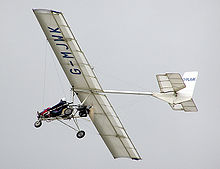
Huntair Pathfinder Mark 1 ultralight
Ultralight aviation (called microlight aviation in some countries) is the flying of lightweight, 1- or 2-seat fixed-wing aircraft. Some countries differentiate between weight-shift control and conventional 3-axis control aircraft with ailerons, elevator and rudder, calling the former "microlight" and the latter "ultralight".
During the late 1970s and early 1980s, mostly stimulated by the hang gliding movement, many people sought affordable powered flight. As a result, many aviation authorities set up definitions of lightweight, slow-flying aeroplanes that could be subject to minimum regulations. The resulting aeroplanes are commonly called "ultralight aircraft" or "microlights", although the weight and speed limits differ from country to country. In Europe, the sporting (FAI) definition limits the maximum take-off weight to 450 kg (992 lb) (472.5 kg (1,042 lb) if a ballistic parachute is installed) and a maximum stalling speed of 65 km/h (40 mph). The definition means that the aircraft has a slow landing speed and short landing roll in the event of an engine failure.[1]
In most affluent countries, microlights or ultralight aircraft now account for a significant percentage of the global civilian-owned aircraft. For instance in Canada in February 2018, the ultralight aircraft fleet made up to 20.4% of the total civilian aircraft registered.[2] In other countries that do not register ultralight aircraft, like the United States, it is unknown what proportion of the total fleet they make up. In countries where there is no specific extra regulation, ultralights are considered regular aircraft and subject to certification requirements for both aircraft and pilot.
Contents
1 Definitions
1.1 Australia
1.2 Canada
1.3 United Kingdom
1.4 New Zealand
1.5 United States of America
2 Types of aircraft
2.1 Electric powered ultralights
3 See also
4 References
5 External links
Definitions
| Country | Type | Capacity | MTOW | Time | Licence | Other conditions | |
|---|---|---|---|---|---|---|---|
| Australia | Recreational Aircraft[3] | 2 | 600 kg; 614 kg for seaplane | — | — | — | |
Light Sport Aircraft[4] | 2 | 600 kg; 650 kg for seaplane | — | — | — | ||
| Brazil | Ultralight | 2 | 750 kg | daylight visual conditions | — | used mainly, or intended for, sports or recreation[5] | |
| Canada | basic ultra-light aeroplane | 2 | 1,200 lb (544 kg) | daylight visual conditions | Ultralight Pilot Permit | may be operated from land or water | |
| advanced ultra-light aeroplane | 2 | 1,232 lb (559 kg) | daylight visual conditions | Ultralight Pilot Permit | may only carry a passenger if the pilot has an Ultralight Aeroplane Passenger Carrying Rating; may operate at a controlled airport without prior arrangement[6] | ||
| Europe[7] | land plane/helicopter, single-seater | 1 | 300 kg | — | — | — | |
| land plane/helicopter, two-seater | 2 | 450 kg | — | — | — | ||
| amphibian or floatplane/helicopter single-seater | 2 | 495 kg | — | — | where operating both as a floatplane/helicopter and as a land plane/ helicopter, it falls below both MTOW limits, as appropriate | ||
| land plane, two-seater equipped with an airframe mounted total recovery parachute system | 2 | 472.5 kg | — | — | — | ||
| land plane single-seater equipped with an airframe mounted total recovery parachute system | 1 | 315 kg | — | — | — | ||
| gyroplane | 1–2 | 560 kg | — | — | — | ||
| India | — | 2 | 450 kg without parachute | — | current permit to fly[8] | — | |
| Italy | ultraleggero | 1—2 | Max Take Off Weight MTOW 2 persons, 472.5 kg (450 kg without parachute) Kg 500 Hydroplanes Single Kg. 300; Hydroplane single Kg. 330 Stall speed 65 km/h. | Daylight, minimum of 500 ft (152 m). | certificate exam, insurance and a medical examination.[9] | requires a helmet only for open cockpit aircraft. flying over populated areas and people asseblyes is prohibited.[10] | |
| New Zealand | NZ Class 1 | 1 | 510 kg, 550 kg for seaplanes | — | — | — | |
| NZ Class 2 | 2 | 600 kg, 650 kg for seaplanes | — | — | — | ||
| Philippines | non-type certified aircraft[11][12] | — | — | daytime VFR | — | recreational and sport use | |
| United Kingdom | Sub-70kg Unregulated, Single Seat De-Regulated, Two seat Regulated. | 1–2[13] | Several definitions, from 70kg empty weight to 472.5kg maximum weight at take-off | Daytime VFR | Licence not required for sub 70kg empty weight, else NPPL licence required[14][15] | Recreational. No paid work. | |
| United States | ultralight aircraft | 1 | 155 lb (70 kg) for unpowered, with extra weight allowed for amphibious landing gear and ballistic parachute systems[16][17] | daylight hours | no license required | less than 5 US gallons (19 L) fuel capacity, empty weight of less than 254 pounds (115 kg), a top speed of 55 knots (102 km/h or 64 mph), and a maximum stall speed not exceeding 24 knots (45 km/h or 27.6 mph). May only be flown over unpopulated areas. | |
| light-sport aircraft | — | — | — | sport pilot certificate | — |

Pegasus Quantum 145-912 ultralight trike
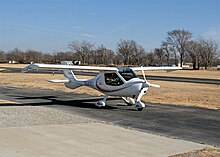
Flight Design CTSW
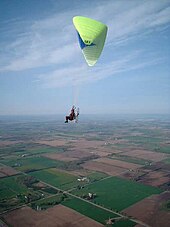
A powered paraglider
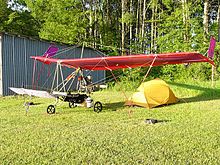
A US-made Pterodactyl Ascender ultralight on a camping flight
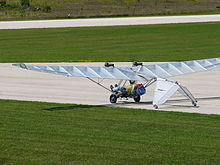
Canadian Lazair ultralight covered in clear Mylar

A weight-shift ultralight, the Air Creation Tanarg

Quicksilver MXII
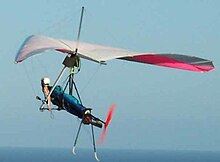
A foot-launched powered hang glider
Australia
In Australia, ultralight aircraft and their pilots can either be registered with the Hang Gliding Federation of Australia (HGFA)[18] or Recreational Aviation Australia (RA Aus).[19] In all cases, except for privately built single seat ultralight aeroplanes,[20] microlight aircraft or trikes are regulated by the Civil Aviation Regulations.
Canada
United Kingdom
Paramotor and powered hang-glider pilots (including those flying aircraft with wheels) do not need a licence, provided the weight of the aircraft is not more than 75 kg (165 lb), but they must obey the rules of the air.[21]
For heavier microlights the current UK regulations match the European ones, except that helicopters and gyroplanes are not included.[22]
Earlier UK microlight definitions described an aeroplane with a maximum weight of (finally) 390 kg (860 lb), and a maximum wing loading of 25 kg (55 lb) per square metre. Other than the very earliest aircraft, all two-seat UK microlights (and until 2007 all single-seaters) have been required to meet an airworthiness standard; BCAR Section S.[23]
In 2007, Single Seat DeRegulated (SSDR), a sub-category of single seat aircraft was introduced, allowing owners more freedom for modification and experiments. By 2017 the airworthiness of all single seat microlights became solely the responsibility of the user, but pilots must hold a microlight licence;[24] currently NPPL(M) (National Private Pilots Licence).
New Zealand
Ultralights in New Zealand are subject to NZCAA General Aviation regulations[25] with microlight specific variations as described in Part 103[26] and AC103.[27]
United States of America
The United States FAA's definition of an ultralight is significantly different from that in most other countries and can lead to some confusion when discussing the topic. The governing regulation in the United States is FAR 103 Ultralight Vehicles. In 2004, the FAA introduced the "Light-sport aircraft" category, which resembles some other countries' microlight categories. Ultralight aviation is represented by the United States Ultralight Association (USUA), which acts as the US aeroclub representative to the Fédération Aéronautique Internationale.
Types of aircraft
There are several categories of aircraft which qualify as ultralights in some countries:
Fixed-wing aircraft: traditional airplane-style designs.
Weight-shift control trike: use a hang glider-style wing, below which is suspended a three-wheeled carriage which carries the engine and aviators. These aircraft are controlled by pushing against a horizontal control bar in roughly the same way as a hang glider pilot flies.
Powered parachute: fuselage-mounted engines with parafoil wings, which are wheeled aircraft.
Powered paraglider: backpack engines with parafoil wings, which are foot-launched.
Powered hang glider: motorized foot-launched hang glider harness.
Autogyro: rotary wing with fuselage-mounted engine, a gyrocopter is different from a helicopter in that the rotating wing is not powered, the engine provides forward thrust and the airflow through the rotary blades causes them to autorotate or "spin up" thereby creating lift.
Helicopter: there are a number of single-seat and two-place helicopters which fall under the microlight categories in countries such as New Zealand. However, few helicopter designs fall within the more restrictive ultralight category defined in the United States of America.
Hot air balloon: there are numerous ultralight hot air balloons in the US, and several more have been built and flown in France and Australia in recent years. Some ultralight hot air balloons are hopper balloons, while others are regular hot air balloons that carry passengers in a basket.
Electric powered ultralights
Advancements in batteries, motors, and motor controllers has led to some practical production electric propulsion systems for some ultralight applications. In many ways, ultralights are a good application for electric power as some models are capable of flying with low power, which allows longer duration flights on battery power.[28]
In 2007, the first pioneering company in this field, the Electric Aircraft Corporation, began offering engine kits to convert ultralight weight shift trikes to electric power. The 18 hp motor weighs 26 lb (12 kg) and an efficiency of 90% is claimed by designer Randall Fishman. The battery consists of a lithium-polymer battery pack of 5.6kWh which provides 1.5 hours of flying in the trike application. The company claimed a flight recharge cost of 60 cents in 2007.[28][29]
A significant obstacle to the adoption of electric propulsion for ultralights in the U.S. is the weight of the battery, which is considered part of the empty weight of the aircraft despite efforts to have it considered as fuel.[30] As battery energy density improves lighter batteries can be used.
See also
- Aerosport (airshow)
- Backpack helicopter
- Jetpack
- Nanolight
- Experimental Aircraft Association
- Recreational Aviation Australia
- United States Ultralight Association
- United States Powered Paragliding Association
- Volksflugzeug
References
^ Boric, Marino, Spoilt For Choice, Bayerl, Robby; Martin Berkemeier; et al (editors): World Directory of Leisure Aviation 2011-12, page 10. WDLA UK, Lancaster UK, 2011. .mw-parser-output cite.citationfont-style:inherit.mw-parser-output qquotes:"""""""'""'".mw-parser-output code.cs1-codecolor:inherit;background:inherit;border:inherit;padding:inherit.mw-parser-output .cs1-lock-free abackground:url("//upload.wikimedia.org/wikipedia/commons/thumb/6/65/Lock-green.svg/9px-Lock-green.svg.png")no-repeat;background-position:right .1em center.mw-parser-output .cs1-lock-limited a,.mw-parser-output .cs1-lock-registration abackground:url("//upload.wikimedia.org/wikipedia/commons/thumb/d/d6/Lock-gray-alt-2.svg/9px-Lock-gray-alt-2.svg.png")no-repeat;background-position:right .1em center.mw-parser-output .cs1-lock-subscription abackground:url("//upload.wikimedia.org/wikipedia/commons/thumb/a/aa/Lock-red-alt-2.svg/9px-Lock-red-alt-2.svg.png")no-repeat;background-position:right .1em center.mw-parser-output .cs1-subscription,.mw-parser-output .cs1-registrationcolor:#555.mw-parser-output .cs1-subscription span,.mw-parser-output .cs1-registration spanborder-bottom:1px dotted;cursor:help.mw-parser-output .cs1-hidden-errordisplay:none;font-size:100%.mw-parser-output .cs1-visible-errorfont-size:100%.mw-parser-output .cs1-subscription,.mw-parser-output .cs1-registration,.mw-parser-output .cs1-formatfont-size:95%.mw-parser-output .cs1-kern-left,.mw-parser-output .cs1-kern-wl-leftpadding-left:0.2em.mw-parser-output .cs1-kern-right,.mw-parser-output .cs1-kern-wl-rightpadding-right:0.2em
ISSN 1368-485X
^ Transport Canada (February 2018). "Canadian Civil Aircraft Register: Number of Aircraft by Category Result". Retrieved 20 March 2018.
^ An overview of the legislative framework enabling sport and recreational aviation Archived 2011-12-23 at the Wayback Machine. Accessed 7 January 2012
^ Kiehn, Chris (15 July 2013). "Synopsis: the Light Sport Aircraft category". Archived from the original on 19 August 2006. Retrieved 12 July 2013.
^ "RBHA 103A regulation, in Portuguese" (PDF). Archived from the original (PDF) on 29 January 2011. Retrieved 21 September 2009.
^ Transport Canada (30 December 2007). "Canadian Aviation Regulations, Part I - General Provisions, Subpart 1 - Interpretation". Retrieved 22 March 2009.
^ Joint Aviation Authorities (1 November 2004), JAR 1, retrieved 7 February 2015
^ Microlight Aviation (2008). "Microlight/ultralight FAQs". Archived from the original on 5 January 2015. Retrieved 17 July 2008.
^ "Laws and regulations on ultralight aviation in Italy" (in Italian). 2011. Retrieved 2 March 2011.
^ "Presidential decree 9 July 2010, n.133" (PDF) (in Italian). 2011. Retrieved 2 March 2011.
^ Angeles City Flying Club, Excerpt from part 11 of the Civil Aviation Regulations.
^ Civil Aviation Authority Philippines Archived 2009-04-22 at the Wayback Machine., download page for all regulations.
^ "The British Microlight Aircraft Association, new page 3786". www.bmaa.org. Retrieved 21 May 2018.
^ British Microlight Aircraft Association. "[1]". Retrieved 24 July 2015
^ British Microlight Aircraft Association. "Licensed Flying, so you want to be a pilot?". Retrieved 24 July 2015
^ Federal Aviation Administration (January 2007). "Title 14: Aeronautics and Space, Part 103 - Ultralight Vehicles". Archived from the original on 19 January 2011. Retrieved 4 February 2011.
^ United States Ultralight Association (2009). "Frequently asked Questions". Retrieved 4 February 2011.
^ Hang Gliding Federation of Australia (n.d.). "The HGFA". Retrieved 25 May 2008.
^ Recreational Aviation Australia Inc (August 2007). "About the RA-Aus association and our mission". Archived from the original on 19 May 2008. Retrieved 25 May 2008.
^ Legal Services Group Civil Aviation Safety Authority (July 2007). "PART 200 Aircraft to which CASR do not apply". Retrieved 25 May 2008.
^ "The British Microlight Aircraft Association, new page 3852". www.bmaa.org. Retrieved 21 May 2018.
^ British Civil Aviation Authority Aircraft Types
^ [2]
^ "The British Microlight Aircraft Association, new page 3852". www.bmaa.org. Retrieved 21 May 2018.
^ Civil Aviation Rules, Accessed 7 January 2012
^ Part 103 - Microlight Aircraft - Operating Rules, Accessed 7 January 2012
^ Advisory Circular 103, Accessed 30 May 2018
^ ab Grady, Mary (April 2008). "Electraflyer Flies Trike, Motorglider On Battery Power". Retrieved 13 April 2008.
^ Electric Aircraft Corporation (2007). "ElectraFlyer Technical details". Archived from the original on 16 October 2007. Retrieved 13 April 2008.
^ "Experimenter - February 2013". epubxp.com. Retrieved 16 August 2015.
External links
![]() Media related to Ultralight aircraft at Wikimedia Commons
Media related to Ultralight aircraft at Wikimedia Commons
